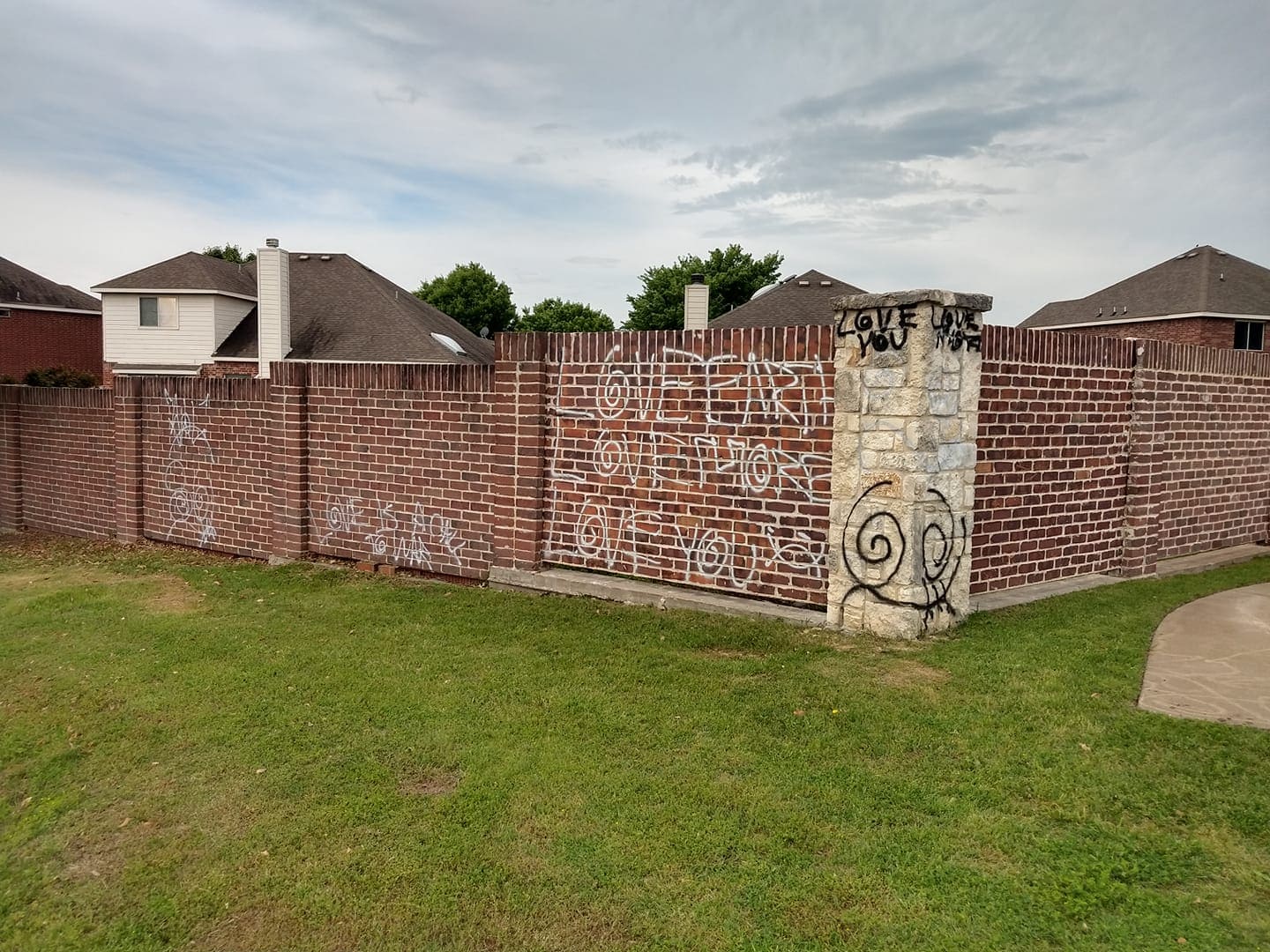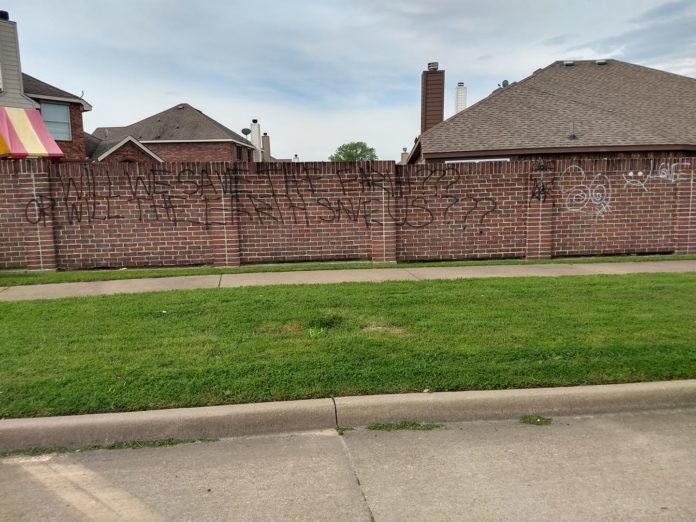Red Oak- Red Oak residents are fed up with the recent “work” of taggers in the area. Not only is the graffiti an eyesore but residents are spending hundreds of dollars to have the tags cleaned up.
Yesterday the Red Oak Police Department posted the following on their Facebook page:
The Red Oak Police Department recently has responded to a very unusual number of tagging offenses around town. Tagging is a global problem costing millions of dollars annually in the cost of repairs. While considered urban art by some it is mostly simply a criminal nuisance.
What is tagging graffiti: Graffiti tag is usually written with marker or spray paint and in one color, which is sharply contrasted with its background. Tag is a stylized personal signature and contains graffiti writer’s name, also known as a moniker.
Different Types of Graffiti
A tag is the most basic writing of an artist’s name; it is simply a handstyle. A graffiti writer’s tag is his or her personalized signature. Tagging is often the example given when opponents of graffiti refer to any acts of handstyle graffiti writing (it is by far the most common form of graffiti). Tags can contain subtle and sometimes cryptic messages, and may incorporate the artist’s crew initials or other letters.
One form of tagging, known as pissing, involves taking a refillable fire-extinguisher and replacing the contents with paint, allowing for tags as high as approximately 20 feet (6.1 m). Aiming and keeping a handstyle steady in
this form of tagging is very difficult, usually coming out wavy and sloppy.
Another form is the throw-up, also known as a bombing, which is normally painted very quickly with two or three colors, sacrificing aesthetics for speed. Throw-ups can also be outlined on a surface with one color.
A piece is a more elaborate representation of the artist’s name, incorporating more stylized letters, usually incorporating a much larger range of colors. This is more time-consuming and increases the likelihood of the artist getting caught.
A blockbuster or roller is a large piece, almost always done in a block-shaped style, done simply to cover a large area solidly with two contrasting colors, sometimes with the whole purpose of blocking other writers from painting on the same wall. These are usually accomplished with extended paint rollers and gallons of cheap exterior paint.
A more complex style is wildstyle, a form of graffiti usually involving interlocking letters and connecting points. These pieces are often harder to read by non-graffitists as the letters merge into one another in an often-undecipherable manner.
The graffiti is a very unfortunate set of circumstances that is not only costly and unsightly but criminal in nature.

Red Oak PD Dedicates Additional Resources
We currently have dedicated some additional resources to attempt to root out this issue while dealing with this nuisance and criminal activity and all of our other responsibilities and call for service. We have increased neighborhood patrols with marked units and have dedicated some additional resources to surveil the areas with the hopes of catching it in progress. The reality is that catching an in-progress offense is very unlikely without the help of the community. Last month we conducted 1,382 Neighborhood Patrols/Checks and an additional 1,558 Building/Business Checks which is a slight uptick but pretty consistent month to month.
We currently do not have any specific suspects we are looking at for the recent offenses. We are asking the community to help us keep an eye out for activity late at night and for people wandering the streets that may be responsible for the criminal behavior. We have established a general profile of the offenders based on what we have seen in the tagging locations.
We ask if you see or hear suspicious activity please contact the Northern Ellis Emergency Dispatch Center at 972-775-3333 or utilize 911 and report the suspicious activity.
Our social media pages are not staffed twenty-four a day so that is not the best method of contacting us for immediate responses.
Things to know about graffiti:
It’s common knowledge that damaging or tampering with someone else’s property is against the law. Even childish vandalism offenses like egging a car or spray painting a fence can lead to serious penalties. Under Texas law, many forms of vandalism are charged as criminal mischief. This quick review will get you up to speed on vandalism laws in Texas.
Criminal Mischief Charges in Texas
Criminal mischief is a broadly defined crime that punishes willful behavior aimed at destroying, altering, or defacing property belonging to another. Under Texas law, a person is guilty of criminal mischief if they intentionally or knowingly perform any of the following acts without the consent of the property owner:
Damage or destroy the tangible property of the owner;
Tamper with the tangible property of the owner, causing monetary loss or substantial inconvenience to the owner or a third person; or
Make markings, including inscriptions, slogans, drawings, or paintings, on the tangible property of the owner.
Since this is a specific intent crime, the prosecution must prove that the defendant acted with purpose, knowing that their act damaged or tampered with another person’s property. Common defenses to criminal mischief are mistake of fact or accident. Without proof of intent, you can be charged with reckless damage or destruction, which occurs when one recklessly damages or destroys another’s property without consent.
Penalties for Criminal Mischief
Punishment for criminal mischief is scaled to meet the seriousness of the crime; but as the chart below reflects, most violations are charged as misdemeanors. Basically, the greater the value of the property involved, the stiffer the penalty.
For example, vandalism resulting in less than $100 in damage is considered a fine-only offense. However, when property damage is valued between $750 and $2,500, you could face up to one year in jail and fines as much as $4,000.
Understanding Texas Graffiti Charges
It’s not uncommon for other crimes to be alleged along with a criminal mischief charge. Graffiti is a related property crime that involves the unauthorized writing or drawing on a wall or other surface.
Under Texas law, a person commits a graffiti offense if, without the consent of the owner, the person intentionally makes markings, drawings, or paintings on someone else’s tangible property with:
Paint;
Indelible marker; or
An etching or engraving device.
Overview of Texas Vandalism Laws
The following chart highlights important aspects of the Texas law on criminal mischief and related property crimes.
Texas Statutes
Texas Penal Code § 28.03 Criminal Mischief
Texas Penal Code § 28.08 Graffiti
Texas Penal Code § 28.04 Reckless Damage or Destruction
Penalties for Criminal Mischief
If loss is less than $100 or causes substantial inconvenience:
Class C misdemeanor
Punishable by a $500 fine
If loss is more than $100 but less than $750:
Class B misdemeanor
Punishable by up to 180 days in jail and fines up to $2,000
If loss is more than $750 but less than $2,500:
Class A misdemeanor
Also Class A if defendant impairs any public water supply, regardless of the amount of the monetary loss.
Punishable by up to 1 year in jail and fines of up to $4,000
If loss is $2,500 or more but less than $30,000:
State jail felony
Punishable by up to 180 days to 2 years in state jail and fines up to $10,000
If the property was a fence used for the production or containment of livestock:
State jail felony
We thank our community for their concern and know that we are doing everything we can to address this unusual issue for our city. please contact the Northern Ellis Emergency Dispatch Center at 972-775-3333 or utilize 911 and report the suspicious activity.














